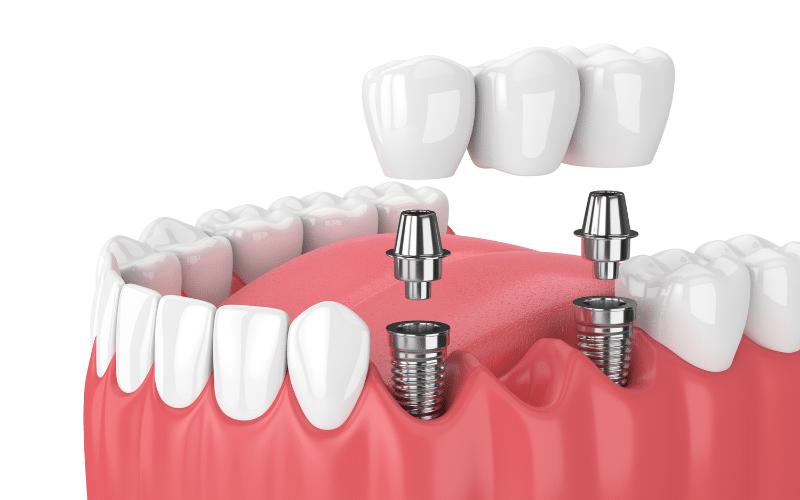Fixed bridges are a mainstay in restorative dentistry, providing an effective, reliable solution for individuals missing one or more teeth. Missing teeth can affect more than just a smile—they can impact chewing, speaking, and the alignment of surrounding teeth, leading to potential long-term complications.
Fixed bridges are designed to restore both functionality and aesthetics, giving patients a complete, stable solution for tooth loss. In this blog, we’ll explore why fixed bridges are essential in restorative dentistry, discussing their benefits, types, and placement process, along with what makes them an ideal option for many patients.
Understand Fixed Bridges
A fixed bridge is a dental restoration used to replace one or more missing teeth. Unlike removable dentures, fixed bridges are permanently attached to surrounding teeth or dental implants, creating a seamless and stable replacement for lost teeth. They consist of one or more artificial teeth, known as pontics, anchored by dental crowns on the adjacent natural teeth or implants.
Types of Fixed Bridges
There are several types of fixed bridges, each designed to meet specific dental needs. Here’s a breakdown of the most common types:
- Traditional Fixed Bridge:
- This is the most common type, using dental crowns on the teeth adjacent to the gap as anchors.
- Ideal for cases where healthy teeth surround the missing tooth area.
- Cantilever Bridge:
- Supported by a single adjacent tooth on one side.
- Typically used when only one adjacent tooth is available, but it’s less common due to the added pressure on the single anchor tooth.
- Maryland Bonded Bridge:
- Uses a metal or porcelain framework bonded to the back of adjacent teeth.
- Minimally invasive and ideal for front teeth replacement, but less durable under strong biting pressure.
- Implant-Supported Bridge:
- Supported by dental implants rather than natural teeth.
- Offers the most stability and is often used when multiple teeth are missing in a row.
Why Are They Important In Restorative Dentistry?
Fixed bridges offer several advantages that contribute to their importance in restorative dentistry. Here’s why they matter:
- Restoring Functionality: Fixed bridges restore the ability to chew and speak clearly by filling the gap left by missing teeth.
- Maintaining Facial Structure: Missing teeth can cause a sunken appearance over time. Fixed bridges help maintain the shape of the face by supporting the surrounding tissue.
- Preventing Tooth Shifting: When a tooth is missing, the surrounding teeth may shift into the open space, leading to misalignment. A fixed bridge prevents this by filling the gap.
- Improving Aesthetics: Fixed bridges provide a natural-looking replacement for missing teeth, helping patients feel confident in their smile.
- Enhancing Oral Health: Bridges are easy to care for and can help improve oral hygiene by preventing food and plaque from accumulating in gaps.
The Fixed Bridge Placement Process
Dentists typically complete the placement of a fixed bridge in a multi-step process over two or more visits. Here’s what patients can expect:
- Initial Consultation and Assessment:
- The dentist evaluates the patient’s oral health, including the health of adjacent teeth.
- The dentist may take X-rays or impressions to assess the bone structure and plan for bridge placement.
- Preparation of Adjacent Teeth:
- The teeth on either side of the gap are prepared to accommodate crowns, which will support the bridge.
- A portion of enamel is removed to make space for the crowns.
- Impressions and Temporary Bridge Placement:
- Impressions of the teeth are taken to create a custom bridge that fits perfectly.
- A temporary bridge is placed to protect the exposed teeth and gums while the permanent bridge is being fabricated.
- Placement of the Permanent Bridge:
- Once the permanent bridge is ready, it is fitted and adjusted for comfort.
- The bridge is then cemented into place, providing a stable, durable replacement for the missing tooth or teeth.
Benefits Of These Bridges Over Other Tooth Replacement Options
While other options like dentures or implants are also effective, fixed bridges offer unique advantages that make them a preferred choice for many patients:
- Permanent Solution: Unlike removable dentures, fixed bridges stay in place, offering a more stable, natural feel.
- Quicker Process Than Implants: Implant-supported bridges require surgery and a longer healing period. Dentists can place fixed bridges in few visits.
- Enhanced Comfort: Fixed bridges don’t shift or slip, providing greater comfort for eating and speaking.
- Cost-Effective Option: Fixed bridges are typically more affordable than implants and offer a durable, long-lasting solution.
Maintaining & Caring for Fixed Bridges
Proper maintenance is essential for the longevity of fixed bridges. Here are some tips to keep a fixed bridge in top condition:
- Brush and Floss Daily: Use a soft-bristled toothbrush and ensure you floss under the bridge to remove plaque buildup.
- Use Special Floss or Interdental Brushes: Dental floss threaders or interdental brushes are ideal for cleaning around the bridge and ensuring thorough hygiene.
- Regular Dental Checkups: Routine dental visits allow our dentist to monitor the bridge and ensure it remains in good condition.
- Avoid Hard or Sticky Foods: Hard and sticky foods can damage the bridge, so try to avoid these to keep the bridge intact.
When Fixed Bridge Is a Right Option?
Fixed bridges are ideal for patients who:
- Have one or more missing teeth with healthy adjacent teeth to support the bridge.
- Want a durable, non-removable solution.
- Prefer a quicker process than dental implants.
- Are looking for a more affordable alternative to implants.
Fixed bridges play a critical role in restorative dentistry, helping patients regain function, aesthetics, and confidence after tooth loss. From traditional to implant-supported options, fixed bridges provide a customizable solution tailored to individual needs.
If you’re considering a fixed bridge or want to learn more about the best tooth replacement options, consult with our dentist. A personalized treatment plan can help you make the best choice, ensuring a comfortable, long-lasting solution for your smile.

